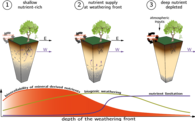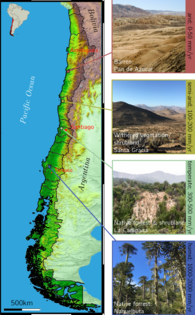


This project is part of the DFG funded Priority Program (SPP 1803) „EarthShape: Earth Surface Shaping by Biota“. In EarthShape BioSoils we will explore the links between denudation (the removal of mass due to chemical and physical weathering and erosion) and soil production (supply of regolith mass from rock or dust) via biogenic weathering.
The rate and degree of rock weathering controls the release, distribution, and cycling of mineral nutrients at the Earth’s surface. This cycling control how ecosystems develop and are sustained.
As substrate gets depleted in mineral and easy bioavailable nutrients (Fig. 1), ecosystems are increasingly nourished by atmospheric inputs, sources such as solutes contained in rain, dust, and volcanic ash. Moreover, nutrients which are depleted in the saprolite accumulate in the soils’ upper part and are increasingly recycled. We hypothesize that the latter is controlled by the nutrient demand of the photoautotroph community of an ecosystem in order to maintain the long-term nutrient status quo. We apply different isotope systems (radiogenic 87Sr/86Sr, stable 26Mg/24Mg, cosmogenic 10Be/9Be) in order to elucidate and better understand the feedbacks between the bio- and geosphere under different climatic conditions.
The four EarthShape primary study areas (Fig. 2) feature an outstanding vegetation gradient controlled by climate, ranging over 2000 km from arid, to temperate, to humid conditions. The sites are within 80 km of the Pacific coast and are located on granodioritc lithology. Moreover, the sites were unglaciated during the LGM and are situated in nature reserves, where anthropogenic influence is minimized.
Contact
- Dr. Ralf Oeser (ralf.oeser(at)icloud.com)
Duration of project
- 2016 - 2018
Funding
- DFG "EarthShape: Earth Surface Shaping by Biota" (SPP 1803)


